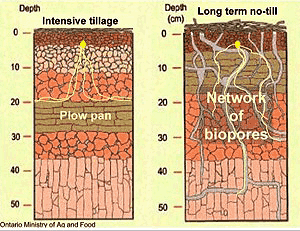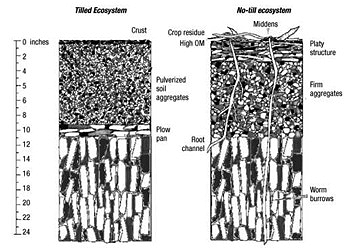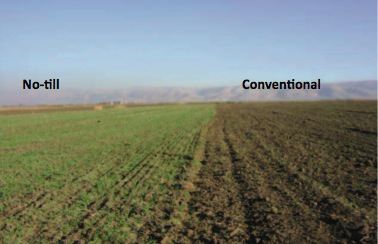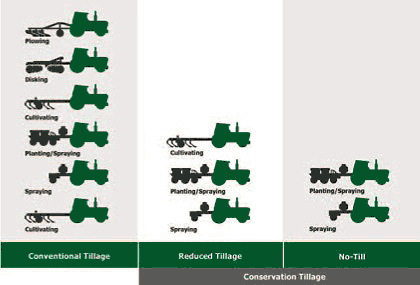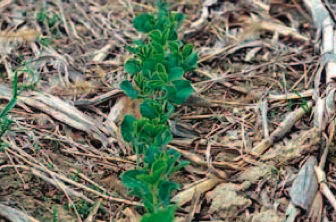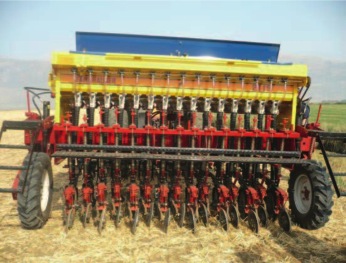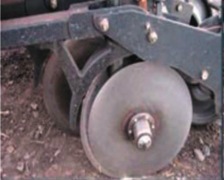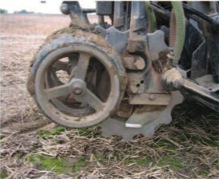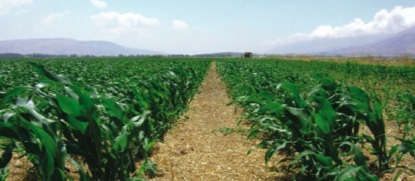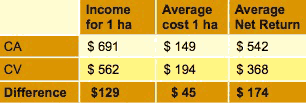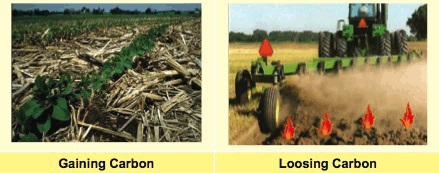Conservation Agriculture - Principles and General Procedures
|
|
Principles of Conservation Agriculture:Conservation Agriculture (CA) is an approach to managing agro-ecosystems for improved and sustained productivity, increased profits and food security while preserving and enhancing the resource base and the environment. CA is characterized by three linked principles, namely:
All principles are universally applicable to all agricultural landscapes and land uses with locally adapted practices. CA enhances biodiversity and natural biological processes above and below the ground surface. Soil interventions such as mechanical soil disturbance are reduced to an absolute minimum or avoided, and external inputs such as agrochemicals and plant nutrients of mineral or organic origin are applied optimally and in ways and quantities that do not interfere with, or disrupt, the biological processes.
CA facilitates good agronomy, such as timely operations, and improves overall land husbandry for rainfed and irrigated production. Complemented by other known good practices, including the use of quality seeds, and integrated pest, nutrient, weed and water management, etc., CA is a base for sustainable agricultural production intensification. It opens increased options for integration of production sectors, such as crop-livestock integration and the integration of trees and pastures into agricultural landscapes.
CA and other similar systems for intensive farming have been successfully tested and applied by farmers in many parts of the world over the past 40 years. Though these systems vary in the technologies applied across countries, climates, soils and crop types, their common features are that they enable farmers to create conditions favourable to biotic activity in the soil. Only a living soil can be a productive soil.
Although much of the CA development to date has been associated with rainfed arable crops, farmers can apply the same principles to increase the sustainability of irrigated systems, including those in semi-arid areas. CA systems can also be tailored for orchard and vine crops with the direct sowing of field crops, cover crops and pastures beneath or between rows, giving permanent cover and improved soil aeration and biodiversity. CA systems do not replace but should be integrated with current good land husbandry practices.
Minimum disturbance of soil:Soil is a living organism and therefore has to be treated as such. Soil organisms are destroyed by exposure to solar radiation and rapid drying of the soil. Soil tillage, especially inversion by using mouldboard ploughs, enhances the decomposition of organic matter in the soil and leads to soil compaction especially the formation of a plough pan, reduced water infiltration and reduced aeration. Instead, no-tillage and a good soil cover, enhances soil “life” leading to the formation of a deep reaching macropores or biopores, enabling water infiltration and aeration. For most soils – especially the tropical ones - organic matter assures is central for the storage of nutrients and water in the soil.
Figure 1: Changes in soil structure under no-tillage system
A further problem is that without sufficient quantities of organic matter in the soil, the efficiency and effectiveness of mineral fertilizers is greatly reduced. Practical solutions include direct planting through mulch, using special equipment or minimum tillage through which a planting line (furrow) is opened for planting seeds (the same can be done using a hand hoe).
Maintenance of a soil cover:Soils need to be protected against the impact of raindrops, wind and solar radiation through a cover of crop residues or cover crops. Soil cover effectively reduces soil erosion by water and wind. It impedes the loss of precious rainwater by water run-off, allowing increased water infiltration and reduced evaporation. Soil cover leads to a low and stable soil temperatures - overheating during daytime is prevented, as is rapid cooling-off after sunset. Soil cover ultimately results in a more favourable environment, which is also beneficial to soil organisms. Practices such as burning of crop residues are juxtaposed to this principle.
Crop rotation:Suitable crop rotations, sequences and combinations, adapted to local socioeconomic and environmental conditions, contribute to maintaining biodiversity above and in the soil. This helps to avoid build-up of pest populations within the spectrum of soil inhabitants. Where irrigation is feasible crop, rotations can be enriched by growing vegetables such as onions or potatoes under CA, for example by growing potatoes underneath a soil cover and using drip irrigation.
No-Tillage/Zero-Tillage or Direct Planting:No-tillage or zero-tillage means planting, directly into the soil without any seedbed preparation. The soil remains undisturbed. Herbicides (pre-planting application) are applied before planting to kill weeds. No-tillage without a soil cover may lead to greater surface sealing thus causing greater surface run-off and soil erosion.
Photo 2: Comparison of results of conventional versus zero-tillage Minimum Tillage:This method includes non-turning or superficial tillage while at the same time simply opening of planting rows with a chisel or ripper tine (furrow). Ripping, planting and fertilizer application can be combined in one single operation. This method is an option for situations where full ground cover can be achieved (e.g. semi-arid and arid regions). This method is frequently applied in south-eastern Africa. As the use of direct drills requires an even surface, minimum tillage lends itself well for special crops and crop rotations including tuber crops, e.g., potatoes. As an alternative to rippers special direct drills have been developed that are capable of coping with a disturbed surface (e.g. Swedish Väderstad machines).
Practising CA:Changes in mechanization and field operationsThe most significant change from tillage-based farming to CA is in the land preparation and seeding practices. Equipment for seeding and planting must be able to deposit the seed with a similar accuracy of conventional seed drills into an untilled soil which ideally is covered with a heavy mulch of crop residues. For this reason the equipment must have specially designed furrow openers which can penetrate the mulch without collecting it or pushing it into the soil while at the same time delivering the seed into the soil at the desired depth. In order to do this, no-till direct seeding equipment is usually strong enough to resist the higher soil forces, and heavier than a conventional seed drill, particularly when disk type furrow openers are used.
Figure 3: Moving from conventional to no-tillage system
Equipment for weed management remain partly unchanged under CA system. While cultivators and hoe type equipment loose importance in CA systems, slashers, cutters or crimper-rollers are used for mechanical surface weed management. Chemical herbicide applicators play a significant role, whereas wick type and low volume applicators (CDA) are of particular importance for small farmers operating manually. Sprayers remain the main tool for herbicide application. In many developing countries, particularly among small farmers, herbicide use is so far unknown and herbicide application is often a completely new operation for these farmers when adopting CA. However, contrary to tillage-based systems, weed management in CA does not necessarily aim at complete elimination or removal of weeds. Important point here is that weeds are not allowed to multiply or interfere with the crop growth. Some cover crops that are nowadays used in CA were previously considered as weeds. The harvest operation in CA is part of the land preparation for seeding the next crop. The management of crop residues during the harvest has direct influence on ease, problems and quality of the subsequent planting operation. Standing residues, anchored in the soil, or at least tall standing stubble can facilitate seeding particularly in high or difficult residue situations, such as in the case of high yielding rice. In semi-arid continental climates with winter precipitation and extremely low winter temperatures, a standing residue or high stubble facilitates water retention. Another important aspect is the treatment of the residues. Photo 4: Residue spreaders rather than using choppers saves energy
Another significant change that is taking place is in the farm power requirements. Without the heavy tillage operation, the required peak farm power is roughly halved. Small-scale farmers who have traditionally used animal traction or single axle tractors can continue the practice under CA, there is no need to hire-in expensive heavy machinery for ploughing. For mechanized agricultural systems the shift towards CA translates in an overall power requirement reduction for tractors by about 50% with an additional shift towards lower horsepower by about 40%. Farmers switching entirely to CA systems this would also mean a significantly lower amount of capital being tied up in expensive farm machinery.
Basic types of seed drillsFor four wheel tractors the full range of no-till seeders and planters is available (from small tractors of 30 hp up to the large tractors of 400 hp). Among the equipment operating with double disk furrow openers, the versions with offset disks of different diameters are particularly popular in Brazil These are very suitable for smaller tractors, since it can cut into most residues and soil conditions with equipment weights of less than 100 kg/row, while other double disk seeders often require weights of 150 to 250 kg/row. Unfortunately, for many developing countries the double disk planters are prohibitively expensive due to the cost for the high quality steel for the disks and the additional weight. On the other hand, chisel type no-till seeders and planters that are favoured in India and China as a low cost equipment for small size tractors, have serious limitations with the residue handling, particularly when seeding small grain cereals like wheat into heavy maize or rice straw residues. In most semiarid and arid regions crop residues are not a constraint and chisel type seeders are better suited for hard soils. For the harvest operation under CA the shift from a two-step harvest, with stationary threshing at the field side or on the farm yard, towards a one stage harvest which combines harvesting and threshing is preferred as this enhances retention and spreading of as much crop residues as possible.
Photo 5: New Brazilian “Fankhauser” No-Till seeder / planter
Photo 6: Double disc furrow opener with off-set discs (up) and cross slot opener, combination chisel and discs (down)
|
|
|
Fertilizer placementMost direct drills have two compartments, one for seeds and one for fertilizer. Fertilizer is applied simultaneously with seeds i.e. it is placed in line about 5 cm besides and beneath the seeds. In a direct seeder this would mean that the furrow opener for fertilizer is offset to one side of the line of work of the seeder. However, in many planters the fertilizer is placed under the seed, but in the same line.
Chemical weed controlAs it is rather difficult in semi-arid and arid regions to provide sufficient ground-cover, due to the low biomass production as well as the livestock competition for crop residues, chemical weed control is necessary even in no-tillage systems. However, this does not mean that more herbicides are applied similar to conventional agriculture. Normally, maximum of two post-emergence applications are sufficient in the absence of a pre-emergence treatment. Herbicides should be changed from time to time in order to prevent the build-up of resistant species.
Important aspects for large scale implementation of CA
Conducive framework conditionsThe following additional framework conditions have also proved successful in promoting the adoption of CA in many countries (some of the approaches may already exist, others may have to be introduced):
Credit linesThe lack of direct drills constitutes a major constraint for the adoption of CA practices. Direct drills are both more expensive compared to conventional drills, and have limited availability amongst suppliers of agricultural equipment (suppliers in-turn hesitate to offer direct drills, as the demand is still limited). The only option in many countries is that farmers have to import direct drill machinery from foreign manufacturers. Generally only large-scale farmers are in the positions to do this. Small-scale farmers cannot afford the costs of such drills. Thus government support is required in order to facilitate access to direct drills. The government has several possibilities: it could reduce import taxes and/or open a low-interest credit line for the purchase of direct drills. This proved to be quite successful in many countries.
Formation of Producer AssociationsIn most Arab countries small-scale farming is predominant. A further approach for making equipment readily available to promote CA is formation of CA farmer or producer associations. The association can then purchase the necessary equipment (e.g. drills, etc) that can then be lent to the members. Producers associations would also facilitate exchange of experience amongst members. Extension agents could address a group of farmers instead giving advice to individuals.
Support of Agricultural Service ProvidersThe widespread adoption of CA practices can also be facilitated through agricultural services providers. They offer services such as use of direct drills or can undertake the sowing of crops on contract basis. Tractor operators who currently offer ploughing and harvesting services should be encouraged to offer CA specific services such as direct drilling. This would ease adoption of CA practices especially by small-scale farmers. The extension service should provide information on different types of direct drills and manufacturers to farm service suppliers, and the government should subsidise importation, either through reduced taxes or credits at favourable conditions. In addition service suppliers need training in the proper use of the CA specific equipment. Service providers should also offer certified seeds, also for drought tolerable crops and forage plants. Seed companies should import these seeds and multiply them locally (international suppliers can be found for example in Tunisia or Australia). |
 |
Photo 7: Maize
|
 |
Economic BenefitsCA is a win-win option. Production costs are reduced, while yields increase over time. The risk of crop failure due to drought is reduced. In dry regions it is mainly the reduction of production costs, less increased yields, which makes CA attractive to farmers, i.e. net returns increase because of savings not of increased revenues. Figures vary of course widely between individual farms, depending on soil type, crop rotation and management, and negative results are not excluded.
Table 1: Comparison of costs (US$) average in Syria of planting 1 ha of wheat with conventional (CV) versus conservation agriculture (CA)
Table 2: Comparison of average net return in Syria of CA and CV fields ($/ha)
Table 3: Economical advantage of CA for farmers
Support of Adaptive ResearchWhile the site-specific application of Conservation Agriculture practices is the task of individual farmers and requires trying and observation, additional research is still needed. More information is required, concerning e.g. crop rotations, weed control, increase of water-use efficiency, CA under fruit trees including olives, and possible solutions to the issue of crop/livestock integration, including alternative forage sources (drought resistant forage crops). Producing vegetables with CA practices is another issue, of special importance for regions where vegetables (including potatoes) are produced as summer crop under irrigation. The national research institutions, should install multi-locational station trials accompanied by on-farm trials in order to find answers to the most urgent questions.
Strengthening Agricultural ExtensionLarge-scale promotion of CA requires coordinated efforts of the extension service. Extension officers have to provide information and advice to farmers and encourage farmers towards changing their production systems. Specific training of extension officers is required. National and international research institutions like ICARDA, CIRAD, CIHEAM or ACSAD should offer training courses for extension officers and farmers. Information materials and training manuals in Arabic have to be produced and disseminated. The organisation of field days is an excellent means of facilitating not only exchange amongst farmers but also providing feedback to extension and research staff.
National and Regional NetworkingExchange of information and experience between practitioners and researchers on the national and regional level is a powerful tool for the promotion of CA. Experience with regional networks in Africa, Latin America and India prove that these networks have helped to enhance the dissemination of CA practices. Networking is done mainly through e-mail and internet, but also through workshops. Networks can produce information bulletins and offer electronic discussion platforms, which allow individuals to ask amongst network members for specific information and experiences. Successful networks have a permanent secretariat and a coordinator. This requires financial support either from the government or development cooperation organisations, at least in the first years. As a start exchange visits by farmers and extension officers could be organised between neighbouring countries.
Regulation of water withdrawals for irrigationAdequate supply of rain and water for agriculture is essential, and it is a commodity with increasing short supply as a result of population increase, greater use of water for urban and industrial requirements and as a result or lower levels of precipatation. Farmers response to the increase in demand for food is often to expand the area under cultivation and/or increase area being irrigated, often by pumping more water either from rivers, dams or from the ground. Poor policies, lack of enforcement of existing laws and regulations lead of over exploitation of water resources. Rivers and lakes shrinks, the water quality is going down and groundwater tables sink at an alarming rate. Governments have to undertake efforts to increase water productivity i.e. to promote agricultural practices that produce “more crop per drop”. This entails regulation and effective control of water withdrawals and pricing and taxation of water consumption. In addition soils policies need to be enforced that prohibit agricultural practices causing water run-off and soil erosion. All this will force farmers to change their production systems and open the door for practices that increase water productivity, including CA practices.
Carbon credit tradingThrough greater adoption of conservation agriculture systems, there is enormous potential to sequester soil organic carbon, which would: (1) help mitigate greenhouse gas emissions contributing to global warming and (2) increase soil productivity and avoid further environmental damage from the un-sustainable use of inversion tillage systems, which threaten water quality, reduce soil biodiversity, and erode soil around the world. Agricultural activities around the world contribute to about 15% to the annual emissions of these greenhouse gases. Research during the past few decades has demonstrated the significant contribution that conservation agricultural systems can have on reducing emission of greenhouse gases, as well as sequestering carbon in soil as organic matter. Increase in the use of agricultural conservation practices helps to positively influence carbon inputs and carbon outputs. Sequestration of soil organic carbon by farmers can provide an environmental commodity that benefits all of society through the mitigation of greenhouse gases. There is evidence that carbon offsets from conservation agriculture can be quantified, verified and traded. Carbon credit trading will provide an economic opportunity for farmers to adopt these ecologically based approaches to farming.
Photo 8: Gaining carbon (adapted from Maurice, Rick, Conservation farming and carbon sequestration (RTM Carbon Forum 2005)
|

